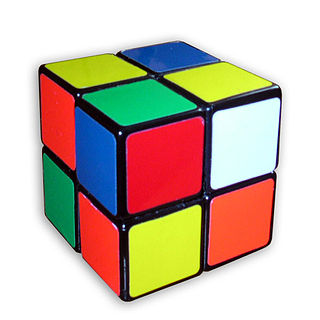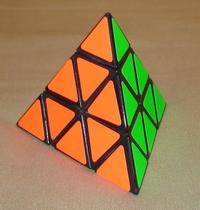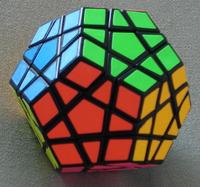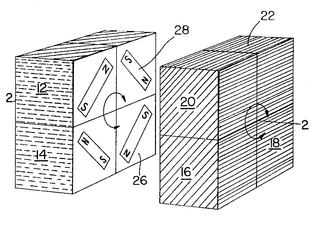
Rubik's Cube is a 3-D combination puzzle invented in 1974 by Hungarian sculptor and professor of architecture Ernő Rubik. Originally called the Magic Cube, the puzzle was licensed by Rubik to be sold by Ideal Toy Corp. in 1980 via businessman Tibor Laczi and Seven Towns founder Tom Kremer and won the German Game of the Year special award for Best Puzzle that year. As of January 2009, 350 million cubes had been sold worldwide, making it the world's top-selling puzzle game. It is widely considered to be the world's best-selling toy.

A mechanical puzzle is a puzzle presented as a set of mechanically interlinked pieces in which the solution is to manipulate the whole object or parts of it. One of the most well-known mechanical puzzles is Ernő Rubik’s Cube that he invented in 1974. The puzzles are mostly designed for a single player where the goal is for the player to see through the principle of the object, not so much that they accidentally come up with the right solution through trial and error. With this in mind, they are often used as an intelligence test or in problem solving training.

The Rubik's Revenge is a 4×4×4 version of Rubik's Cube. It was released in 1981. Invented by Péter Sebestény, the Rubik's Revenge was nearly called the Sebestény Cube until a somewhat last-minute decision changed the puzzle's name to attract fans of the original Rubik's Cube. Unlike the original puzzle, it has no fixed facets: the centre facets are free to move to different positions.

Ernő Rubik is a Hungarian inventor, architect and professor of architecture. He is best known for the invention of mechanical puzzles including Rubik's Cube (1974), Rubik's Magic, Rubik's Magic: Master Edition, and Rubik's Snake.

The Pocket Cube is the 2×2×2 equivalent of a Rubik's Cube. The cube consists of 8 pieces, all corners.

The Professor's Cube is a combination puzzle, a 5×5×5 version of the Rubik's Cube. It has qualities in common with both the original 3×3×3 Rubik's Cube and the 4×4×4 Rubik's Revenge, and knowing how to solve either can help when working on the 5×5×5 cube.

The Pyraminx is a regular tetrahedron puzzle in the style of Rubik's Cube. It was made and patented by Uwe Mèffert after the original 3 layered Rubik's Cube by Erno Rubik, and introduced by Tomy Toys of Japan in 1981.

Rubik's Clock is a mechanical puzzle invented and patented by Christopher C. Wiggs and Christopher J. Taylor. The Hungarian sculptor and professor of architecture Ernő Rubik bought the patent from them to market the product under his name. It was first marketed in 1988.

The Square-1, also known as Back to Square One and Cube 21, is a puzzle similar to the Rubik's Cube. Its distinguishing feature among the numerous Rubik's Cube variants is that it can change shape as it is twisted, due to the way it is cut, thus adding an extra level of challenge and difficulty. The Super Square One and Square Two puzzles have been recently introduced. The Super Square One has two additional layers that can be scrambled and solved independently of the rest of the puzzle, and the Square Two has extra cuts made to the top and bottom layer, making the edge and corner wedges the same size.

The Megaminx or Mégaminx is a dodecahedron-shaped puzzle similar to the Rubik's Cube. It has a total of 50 movable pieces to rearrange, compared to the 20 movable pieces of the Rubik's Cube.
Perplexus is a 3-D ball-in-a-maze puzzle or labyrinth game enclosed in a transparent plastic sphere. By twisting and turning the sphere, players attempt to maneuver a small steel ball through an intricate maze composed of a certain number of steps along narrow plastic tracks. The number of steps ranges from 30 in the Perplexus Twist, to 125 in the Perplexus Epic. Some of the steps involve dropping the ball into a cup or through a small rim to take advantage of its three-dimensional nature. There are obstacles of varying difficulty that must be negotiated in order to reach the end.

A combination puzzle, also known as a sequential move puzzle, is a puzzle which consists of a set of pieces which can be manipulated into different combinations by a group of operations.

The Rubik's Cube, a 1974 invention of Ernő Rubik of Hungary, fascinated people around the globe and became one of the most popular games in America in the early 1980s, having been initially released as the Magic Cube in Hungary in late 1977, and then re-manufactured and released in the western world as Rubik's Cube in 1980. As of January 2009, 350 million cubes have been sold worldwide making it the world's top-selling puzzle game. It earned a place as a permanent exhibit in New York’s Museum of Modern Art and entered the Oxford English Dictionary in 1982. The Cube retains a dedicated following, with almost 40,000 entries on YouTube featuring tutorials and video clips of quick solutions.

Ralph Osterhout is an American inventor, designer, entrepreneur, and CEO of Osterhout Design Group (ODG). During his career he has developed a range of products spanning toys, consumer electronics, dive equipment, furniture to devices for the Department of Defense. Osterhout is named as inventor on 260 patents and patent applications. Over the course of his career, Osterhout has developed over 2,000 different products and hundreds of separate product lines for companies ranging from start-ups to Fortune 500s, as well as the government.
Rubik's Slide electronic puzzle game is a Rubik's-branded combination puzzle produced by TechnoSource in 2010. Players must manipulate the circuit to re-create a specified pattern, with 10,000 puzzles built into the device.
Tony Fisher is a British puzzle designer who specialises in creating custom rotational puzzles. He is acknowledged by cubing enthusiasts as a pioneer in the creation of new puzzle designs and new manufacturing techniques. In 2017 the Guinness Book of World Records acknowledged Fisher as the creator of the world's largest Rubik's cube.

Oskar van Deventer is a Dutch puzzle maker. He prototypes puzzles using 3D printing. His work combines mathematics, physics, and design, and he collaborates at academic institutions. Many of his combination puzzles are in mass production by Uwe Mèffert and WitEden. Oskar van Deventer has also designed puzzles for Hanayama.

Larry D. Nichols, born 1939 in the United States, is a puzzle designer. He grew up in Xenia, Ohio, and studied chemistry at DePauw University in Greencastle, Indiana, before moving to Massachusetts to attend Harvard Graduate School. He is best known for the invention of mechanical puzzles including 'The Nichols Cube Puzzle' (1974), patent US365520. He has lived with his wife Karen in Arlington, Massachusetts since 1959.

The Gear Cube is a 3-D combination puzzle designed and created by Dutch puzzle maker Oskar van Deventer. It was initially produced by Shapeways in 2009 and known as "Caution Cube" due to the likeliness of getting fingers stuck between the gears while speedcubing. Later, in 2010, it was mass-produced by Meffert's as the "Gear Cube".

Prithveesh K. Bhat or Prathvish K. Bhat is an Indian Rubik's Cube speedcuber and mosaic artist. He has set several Rubik's Cube records, including two Guinness World Records namely ′Largest Dual Sided Rubik’s Cube Mosaic′, leading a team of 20 members and ′Most contributions to a Rubik's cube mosaic′, leading a team of 293 people.



















